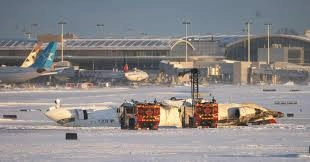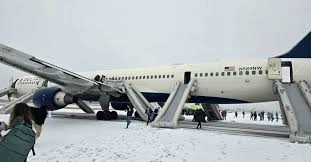Delta plane diverts to Minneapolis, 25 injured after severe storm hits: A closer look
In a tragic incident that has raised concerns about in-flight safety, a Delta Airlines flight from Salt Lake City to Amsterdam was forced to divert to Minneapolis in an emergency after experiencing extreme turbulence. The incident injured 25 people, all of whom were later hospitalized for evaluation and care. The flight, called DL56, had 275 passengers and 13 crew members on board an Airbus A330-900 aircraft.

What Exactly Happened?
According to Delta’s official statement, flight DL56 encountered “severe turbulence” while flying at an altitude of 37,000 feet. Data from flight tracking service Flightradar24 showed that the plane briefly reached an altitude of 38,000 feet, then suddenly descended slightly to 35,800 feet, and eventually stabilized again at 37,000 feet. The turbulence was sudden and strong, causing flight crew members to immediately become concerned.
As a precautionary measure and to ensure the safety of everyone on board, the flight was diverted to Minneapolis-Saint Paul International Airport, where it landed safely. Emergency services were already on standby at the airport as the plane landed, to ensure prompt medical evaluation of all passengers and crew members.
The Aftermath: 25 Hospitalized
Although there was no apparent structural damage to the plane, the vibration was so intense that 25 people on board were injured. All were taken to local hospitals for further examination and treatment. Delta has not detailed the severity of these injuries, but eyewitness reports from passengers indicate that many were thrown out of their seats and hit overhead bins or the cabin ceiling.
One passenger on the flight told a local news outlet, “It was like I was on a roller coaster that suddenly went downhill. People were screaming, things were flying, and I saw someone hit the ceiling.”
The fact that so many people were injured highlights a frequent problem in air travel—the failure to use seatbelts during high flight. Vibrations can occur without warning, and people who are not wearing seatbelts are especially vulnerable.
Understanding Turbulence: A Natural Phenomenon
Turbulence is one of the most common but least understood phenomena in aviation. It refers to irregular air movement that can shake an aircraft, causing sudden changes in its altitude and attitude. Although most turbulence is not dangerous to the aircraft, it can pose serious risks to passengers, especially when they are not wearing seat belts.
There are several types of turbulence, including:
- Clear Air Turbulence (CAT): Often happens at high altitudes and is usually invisible.
- Thermal Turbulence: Caused by hot air rising from the Earth’s surface.
- Mechanical Turbulence: Created when wind flows over obstacles like mountains or buildings.
In the case of Delta Flight DL56, it is likely that the turbulence was Clear Air Turbulence, which can be the most unpredictable and dangerous because it occurs without visible weather indicators like clouds.
Delta’s Response and Safety Protocols
Delta Air Lines responded swiftly to the incident, ensuring that medical teams were ready at Minneapolis. In a statement, the airline said:
“Our immediate focus is taking care of our customers and crew impacted by this rare event. We appreciate the rapid response from emergency services and airport staff.”
The airline also confirmed that all passengers who were not hospitalized were accommodated in hotels and rebooked on alternate flights to Amsterdam.
Delta, like all major airlines, follows strict safety protocols and regularly conducts crew training for such emergencies. The flight crew’s decision to quickly and safely divert the plane is being praised as an example of crisis management at its best.
Growing Incidents of Turbulence: Climate Change to Blame?
Over the past few years, there has been a noticeable rise in reports of severe turbulence across global air routes. Aviation experts have pointed toward climate change as a contributing factor. A 2023 study published in Nature Climate Change suggested that clear air turbulence is expected to increase in frequency and intensity due to rising levels of carbon dioxide in the atmosphere.
Dr. Paul Williams, a professor of atmospheric science and a co-author of the study, noted:
“The jet stream is becoming more unstable as the climate changes, and this is causing an uptick in mid-flight turbulence events.”
This shift poses new challenges for airlines, pilots, and air traffic controllers. Advanced forecasting tools are being developed, but as of now, complete avoidance of sudden turbulence remains difficult.
What Can Passengers Do to Stay Safe?
Though turbulence may never be completely avoidable, there are steps passengers can take to minimize the risk of injury:
- Always Wear Your Seatbelt – Even when the seatbelt sign is off, it’s a good idea to stay buckled.
- Listen to Cabin Crew Instructions – Flight attendants are trained to guide you during emergencies.
- Secure Loose Items – Keep bags and personal items stowed properly to prevent them from becoming projectiles.
- Avoid Standing or Walking Unnecessarily – Especially during long-haul flights where passengers feel tempted to stretch or use the restroom.
A Wake-Up Call for the Aviation Industry
The Delta turbulence incident is a stark reminder of the unpredictable nature of air travel. Although statistically air travel is one of the safest modes of transportation, rare events like this highlight areas for improvement—whether it’s passenger awareness, crew preparation, or real-time weather monitoring.
Airlines may need to revisit their pre-flight safety briefings to emphasize the risks of unexpected turbulence and encourage the routine use of seatbelts. Meanwhile, investments in forecasting technologies and satellite-based weather analysis can help forecast turbulence zones more accurately.
Turbulence and Travel Preparedness
The incident that forced Delta Flight DL56 to be diverted to Minneapolis after severe turbulence and hospitalized 25 passengers has reignited the discussion on air safety in turbulent skies. As climate change and air traffic continue to grow globally, the aviation sector must adapt to new challenges.
For passengers, this incident is an important lesson: turbulence is not just a minor inconvenience but a real threat when safety measures are ignored. Wear your seat belt, stay alert and follow the rules—not just for your own safety, but for the safety of everyone on board.
Follow us for more news at Valleynewz.com

